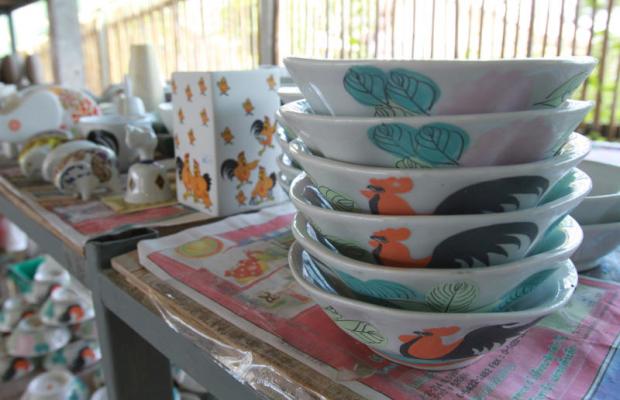
The rooster bowl, the ceramic kitchenware known for a distinctive chicken pattern on its side, is a major product of Lampang province in northern Thailand, the popularity of which has brought financial stability to many locals.
Over 60 years ago, a rooster bowl factory was founded by Chinese immigrants in Lampang. The white clay bowl, with a rooster, a peony and a banana tree hand-painted on its side, sold well and is widely used in restaurants and Thai-Chinese households.
Along the way, rooster-bowl production developed into a major industry in Lampang, already host to pottery and ceramic factories due to the availability of kaolinite.
Lampang has about 200 factories that make rooster bowls. The rooster bowl has become a symbol for the area, and chicken patterns adorn the street signs, bridges and various major structures in the province.
Juthamas Kaewthong, 41, owns Kaewthong Ceramic Factory in Lampang's Koh Kha district. Five years ago, she opened the small factory to make rooster bowls with lids.
Previously, Ms Juthamas had been a ceramic kitchenware distributor. But she decided to make the bowls with lids on her own because they were in short supply.
"I decided to open my own factory with initial capital of about 700,000 baht in 2014," she said. "I got a return on investment from the first year."
Ms Juthamas not only sells the clay bowls at her shop but also supplies them to other ceramic shops nationwide.
Her business allows her to afford to take care of her family, including her parents, she said.
Many ceramic shops line the main road in Lampang that leads to the neighbouring province of Chiang Mai. While there are various ceramics products on display, various rooster bowl designs and patterns are the most prominent.
Shop owners say tourists who shop, Thai or foreign, always opt for rooster bowls because they are "must-buy items", being popular and making good souvenirs from Lampang.
Surasith Kraibuttra, 49, who plans to open a noodle shop in Chiang Mai, said he and his wife will pick rooster bowls as kitchenware for the shop because the bowls go well with its interior, which consists of wood and bare steel.
Moreover, because people often take photos of food served in restaurants, he thinks rooster bowls will impress customers and set his noodle shop apart from the rest.
Mr Surasith plans to buy about 200 rooster bowls for his new noodle shop.
The price of a rooster bowl ranges from 10 baht for a small bowl to more than 300 baht depending on size, paint and production quality.
Dhanabadee Ceramic Group runs a factory in Lampang that was one of the first rooster bowl manufacturing plants in Thailand. Founded by Chinese immigrants, the company is run by the second generation of the founding family.
The factory employs about 200 people, and products are exported to some 70 countries, including China, Japan and the US.
At a museum attached to the factory, a tour guide touted the virtues exemplified by the rooster painted on the bowl, saying the chicken is a symbol of hard-working men and women.
"The picture of a chicken or rooster on the side of the bowl has inspired everyone to work hard and diligently," the guide said. "Every time people eat food from rooster bowls, they are inspired to keep up spirits and be diligent in the same way chickens are."